![]()
![]()
![]()
Use LEFT and RIGHT arrow keys to navigate between flashcards;
Use UP and DOWN arrow keys to flip the card;
H to show hint;
A reads text to speech;
50 Cards in this Set
- Front
- Back
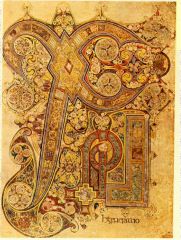
|
Chi-Rho page from Book of Kells, Iona, Scotland, c. 800 (Hiberno-Saxon). irish/british manuscript; book of Christ; very elaborate workmenship;
|
|
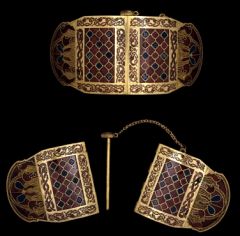
|
Cape clasp from Sutton Hoo, England, first half of 7th century (Anglo-Saxon); small object to hold cape; lots of detail for such a small object; reflects Christian art; it was found in a great tomb hoard; rich panels, very geometric, detailed interlace, typical features of northern style; sutton Hoo was a series of burial mounds; it was looted in the past; one tomb remained, it had the outlines of a ship that was once burried there, lots of gold was burried though, leader or king was buried here;
|
|
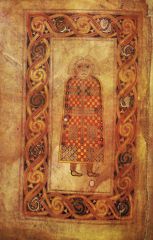
|
Matthew from Book of Durrow, Iona, Scotland, second half of 7th century (Hiberno-Saxon). culture is not basing their ideas off Classicism, but they are rather trying to relate their art to the idea of metalworks, typical of northern art: geometric, colorful, interlacing patterns, looks like metalworks; made of animal skin; this is the page of Matthew the Evangelist who is the angel; we see the color/woven line/geometric shape: looks like metalwork; his body is flat/abstract/simplified (they don't really embrace Classicism)
|
|
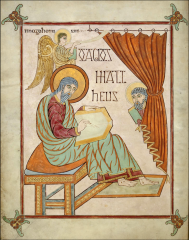
|
Matthew from the Lindisfarne Gospels, Lindisfarne, England, c. 715 (Hiberno-Saxon); very abstract but the artist does this on purpose; not focused on Classicism; it is very geometric; drawing from Northern tradition, draws from the use of metal work; instead of looking shaded and detailed, itis confined within its lines, makes it look like a filled in coloring book; hard to tell spacial depth; very detailed letters; made of calf skins (very expensive material); they want to show their devotion to god
|
|
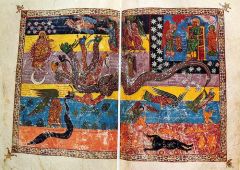
|
Woman clothed in the Sun, from Morgan Beatus, Tabara, Spain, 940 (Spanish Proto-Romanesque);
|
|
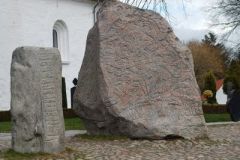
|
Rune stones from Jelling, Denmark, 985 (post-Viking Christian Scandinavia); lots of line and inter weaving of lines (typical of north)
|
|
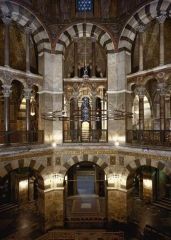
|
Palace Chapel, Aachen, Germany, c. 800 (Carolingian); Charlemagne built it; he copied buildings from Constantine and Justinian, he was trying to rebuild the empire; chapel is inspired by San Vitale, except this one is much flatter faceted; feels really heavy and clunky; king actually attended this church; very angular; flat surfaces
|
|
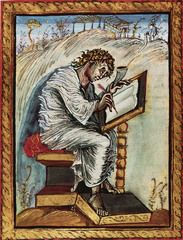
|
Matthew from Ebbo Gospels, 2nd quarter of 9th century (Carolingian); vivid line; pulling away from Classicism; very frantic and fragile line; representation of 3rd style; artist has taken the Classical style and made it really wild and crazy; very dynamic line; sketchy and spontanious; table of contents page: has Classical looking architecture decorating page
|
|
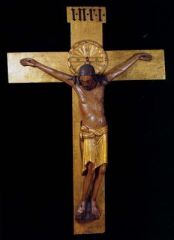
|
Gero Crucifix, Cologne, Germany, c. 970 (Ottonian); life-size; he is showing his pain, see the pain in his face & the way his body hangs
|
|

|
Christ washing the feet of Peter, from Gospels of Otto III, c. 1000 (Ottonian); shows lots of Otto being worshipped; book translates action into lots of flourishing color and detail; Christ washing feet: organization is very geometric; big bug eyes; type of art comes to power after Charlegmagne dies; his kids can't get along, so the empire splits up; Ottonian art: see monumental figures, art is built to last (big powerful buildigns)
|
|
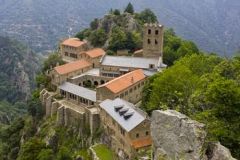
|
Saint-Martin de Canigou, France, c. 1020 (First Romanesque); in the forest; its made of stone; Ottonian cathedrals are far bigger, but this still has vaulted ceilings, it is made of stone: helps prevent fires, helps amplify sound in church; division of the building bc of supporting structure
|
|
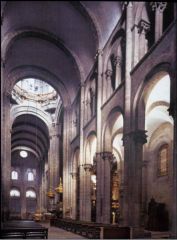
|
Cathedral of Saint James, Santiago de Compostela, Spain, 1078-1122 (Romanesque); it is a pilgramige church: made especially for welcoming guests; has a strong bay system; has two big western towers; it has radiating chapels along the sides; pilgramige church (pilgramige routes helped unify a fragmented church @ the time) pilgramige church made to hold more people so they added extra little chapels on sides & added side isles; each trancept (wing of the churhc) was supposed to look like the main naive so it doesn't matter where you enter
|
|
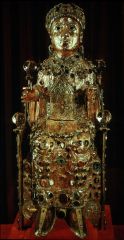
|
Reliquary of St. Foy, from Conques, France, c. 900 and later (Romanesque); people would bring jewels and leave them @ the reliquaries: they would decorate them with the jewels afterwards; people would rob the relics
|
|
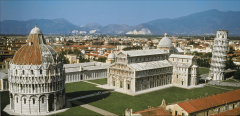
|
Pisa Cathedral complex, Italy, begun 1063 (Romanesque); very boxy, lots of columns bronze doors that describes adventures of the magi (similar to bronze Ottonian doors); timber roof; proportions are taller than what we've seen; no matter how far you get away from Roman antiquity, Roman churches always ahve the strongest influence because they are surrounded by it' has lots of little Roman details, but taking it to the extreme
|
|
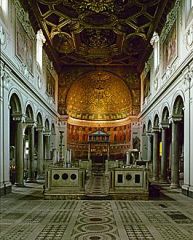
|
San Clemente, Rome, Italy, 1128 (Romanesque); Byzantine influence (gold, the way that Christ is depicted)
|
|

|
Speyer Cathedral, Germany, 1080-1106 and late 12th century (Romanesque); very large, Christian; later on upgraded it by adding barrel vaulted ceilings (was originally wood); walls have alternating rythem flat part, interupted by column; lumbard decoration on outside
|
|
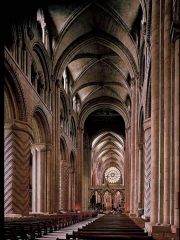
|
Durham Cathedral, England, 1087-1133 (Romanesque); inside of castle complex; has a very heavy Romanesque quality; it has rib vaults & it is combined with pointed arch
|
|
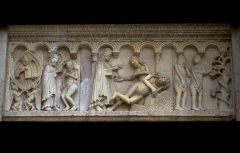
|
Wiligelmo, Creation and Fall, Modena Cathedral, Italy, c. 1100 (Romanesque)
|
|
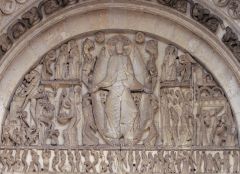
|
Gislebertus, Last Judgment, Autun Cathedral, France, c. 1130 (Romanesque); very Romanesque church; carvings on all the capitals: very vivid and lots of actions; tempanon at front entrance shows last supper; not very realistic structure: made to show what would happen if you sinned, you were damned and the demons would get you; Eve is right over the doorway to the churhc: she is very sexual and exposed: people were angry because they should have given their money to poor people instead of spending it on images of demons and naked women
|
|
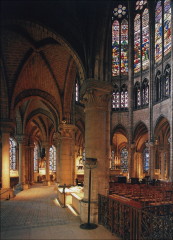
|
Saint Denis, Abbey church choir, France, 1140-44 for bottom, 1231-81 for top (Gothic); has a vertical feel; uses ribbed vaults; architecture made of lines; it is said that this is the birthplace of Gothic style; Saint Denis is closely associated with royalty; very subdivided and light
|
|
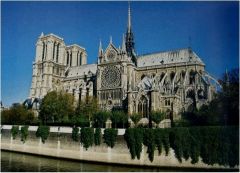
|
Notre-Dame cathedral, Paris, France, begun 1163 (Gothic); much more calm than Laon Cathedral, tighter; has grown over time in series of phases; most of it comes from early Gothic period (part of it comes from high gothic); has flying buttresses (has thin walls and it is very tall so it needs this extra support); west facade is from high gothic period; first to use flying buttresses
|
|
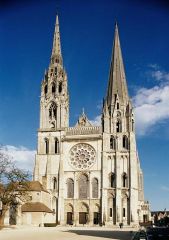
|
Chartres Cathedral, France, west facade, c. 1134 with additions c. 1200 and c. 1500 (Gothic); left tower and rose window aren't original; lots of subdivision in towers; sense of verticalty; sculpture becomes much more 3D and life like; strch last story; diagonal ribs; very thick structure; St Theodore sculpture: very realistic & 3D, high Gothic; stained glass windows tell story of how everyone gets together to help build the church; not accurate: it was supposed to happen this way, but there were lots of riots at the time, so we know the townspeople didn't help: forms of religious propaganda; church isn't even finished; towers yu can see all the way through; pointed above window on door; drapery on statues: very dense/realistic/lots of folding (Neo Classical style: they are immitating Classical Greeks)
|
|
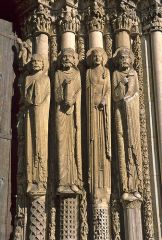
|
Chartres Cathedral, France, "royal portal," c. 1145-55 (Gothic); sculpture becomes much more 3D and life like; strch last story; diagonal ribs; very thick structure; St Theodore sculpture: very realistic & 3D, high Gothic; stained glass windows tell story of how everyone gets together to help build the church; not accurate: it was supposed to happen this way, but there were lots of riots at the time, so we know the townspeople didn't help: forms of religious propaganda; church isn't even finished; towers yu can see all the way through; pointed above window on door; drapery on statues: very dense/realistic/lots of folding (Neo Classical style: they are immitating Classical Greeks)
|
|
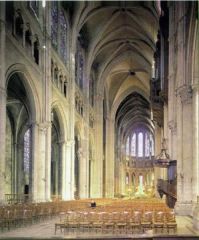
|
Chartres Cathedral, France, interior, 1194-1220 (Gothic); sculpture becomes much more 3D and life like; strch last story; diagonal ribs; very thick structure; St Theodore sculpture: very realistic & 3D, high Gothic; stained glass windows tell story of how everyone gets together to help build the church; not accurate: it was supposed to happen this way, but there were lots of riots at the time, so we know the townspeople didn't help: forms of religious propaganda; church isn't even finished; towers yu can see all the way through; pointed above window on door; drapery on statues: very dense/realistic/lots of folding (Neo Classical style: they are immitating Classical Greeks)
|
|
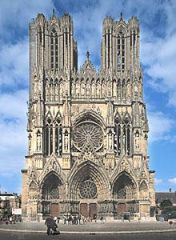
|
Reims Cathedral, France, facade, mid-13th century (Gothic); sculpture: comes from Classical Greek: uses the "passive" Greek facial expressions; wetfolds in clothing
|
|
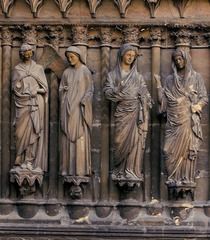
|
Reims Cathedral, France, Annunciation and Visitation, c. 1250 and c. 1230 (Gothic); sculpture: comes from Classical Greek: uses the "passive" Greek facial expressions; wetfolds in clothing
|
|
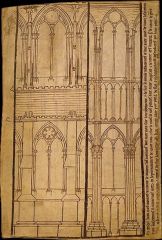
|
Drawings of Reims Cathedral, by Villard de Honnecourt, France, c. 1230 (Gothic);
|
|
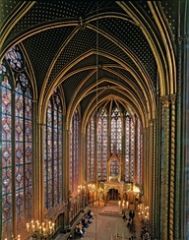
|
Sainte-Chapelle, Paris, France, 1240s (Gothic);
|
|
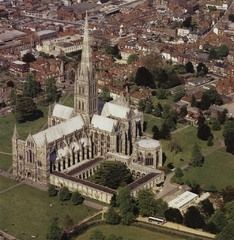
|
Salisbury Cathedral exterior, England, 1220-58 with spire c. 1320 (Gothic); much more horizontal than vertical (which is typical of English Gothic); the English have a crossing spire (right in the center); the English attach the menaster buildings to the cathedral (whereas others make them seperate) ** English Gothic: more horizontal than verticle; located in countryside rather than urban spaces; very decorated
|
|

|
Salisbury Cathedral interior, England, 1220-1258 (Gothic); much more horizontal than vertical (which is typical of English Gothic); the English have a crossing spire (right in the center); the English attach the menaster buildings to the cathedral (whereas others make them seperate) ** English Gothic: more horizontal than verticle; located in countryside rather than urban spaces; very decorated
|
|
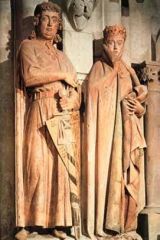
|
Ekkehard and Uta, from Naumburg Cathedral, Germany, c. 1255 (Gothic)
|
|
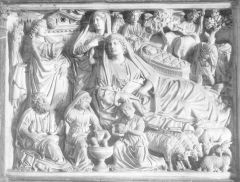
|
Nicola Pisano, detail of nativity from Pisa Baptistery Pulpit, 1260 (Italian "Gothic"); his son was Giovanni Pisano; he is sometimes considered the first Reniassance artist/arcitect, but Bork doesn't
|
|
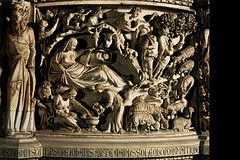
|
Giovanni Pisano, detail of nativity from Pisa Cathedral Pulpit, c. 1300 (Italian "Gothic"); son of Nicola Pisano; his dad was kind of stuck in Classicism, but Giovanni thought that was old school so he began to make his work more Gothic & realistic
|
|
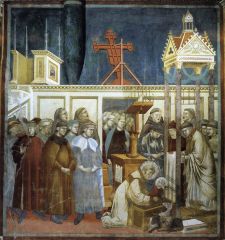
|
Miracle of crib, Saint Francis, Assisi, Italy, c. 1300 (Italian "Gothic");
|
|
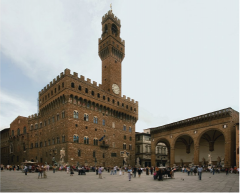
|
Palazzo della Signoria, Florence, Italy, 1299-1310 (Italian "Gothic"); tracing in the windows; more macho & masculine than Siena version (the are rivals)
|
|
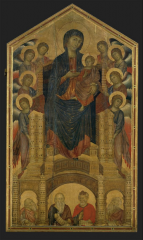
|
Cimabue, Virgin and Child, Florence, Italy, c. 1280 (Italo-Byzantine); teacher of Giotto; his version of Virgin and Child is kind of strange: weird placement in space: angels are standing on top of one another, their halos are like big discs; wetfold clothing
|
|
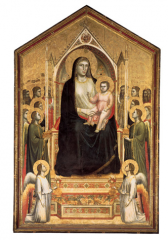
|
Giotto, Virgin and Child, Florence, Italy, 1305-10 (Italian "Gothic"); student of Cimabue; his version of Virgin and Child is more realistic than Cimabue's; angel's placement is more idea; clothing is more realistic
|
|
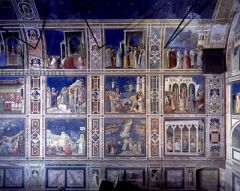
|
Giotto, Scenes from Scrovegni Chapel, Padua, Italy, 1305 (Italian “Gothic”); figures put their backs to you so that it looks like your a by stander and seeing it really happen; his works show a lot of emotion; some people think he is the father of Reniassance, but his ideas are not original: he uses Byzantine art as an influence; realism is key, but Classicism is not
|
|
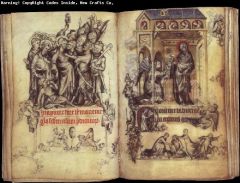
|
Jean Pucelle, Hours of Jeanne d'Evreux, France, 1325-28 (Gothic); using 3D ideas from Giotto; size of deck of cards; page with Virgin: Virgin is very S curved (typical Gothic stance); shows emotion
|
|
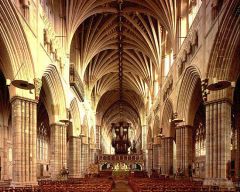
|
Exter Cathedral, England, early 14th century (Gothic); typical of English Gothich (more horizontal than vertical; located in countrysides rather than urban spaces, very decorated); Exter is a good example of decorated style; lots of tracery and curves (typically Northern styles, but is becoming characteristics of English Gothic now)
|
|
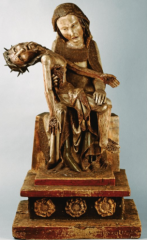
|
Vesperbild (Pieta), from Germany, c. 1330 (Gothic)
|
|
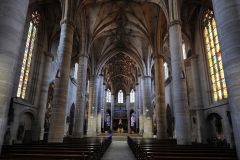
|
Holy Cross church, Schwäbisch Gmünd, Germany, by the Parlers, mid 14th-century (Gothic)
|
|
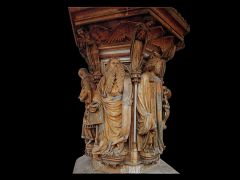
|
Claus Sluter, Well of Moses, Dijon, France, c. 1400 (Late Gothic Realism); Moses is on the sculpture: his face is shown with extreme realism (same with rest of the figures) lines, onf aces, detailed hair, etc...series of angels at top; crucifix above the angels: lots of emotions and realism: Christ's blood is flowing down the side & drops into a pool of water (called the water of life)
|
|
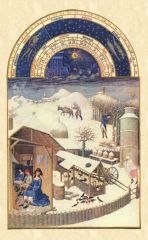
|
Limbourg Brothers, February, from Tres Riches Heures, 1411-16 (Late Gothic Realism); made for the Duke of Berry (major patron of the arts); strong realism: shadows, raggedy details; April page is less realistic (perspective is off) girls are shown very long & slender: same idea from Egyptian art was uses: lower class, slaves were shown in a realistic way, upper class was shown in a different more air-brushed or idealized way
|
|
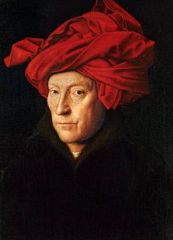
|
Jan van Eyck, Man in a Red Turban, Belgium, 1433 (Late Gothic Realism); uses a lot of hidden symbolism; in pic with man, virign & child: holy one (Jesus) is seperated from the patron by a space in between them: in background there is a river that seperates land of men and land of holy people; only connected by a small bridge, you get there through prayer; Van Ick is in the background (in the Virgins garden); he is often portrayed in this red turban
|
|
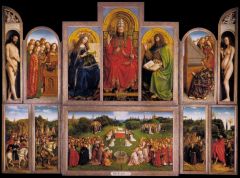
|
Jan and Hubert van Eyck, Ghent altar, Belgium, completed 1432 (Late Gothic Realism); also called Altarpiece of the lamb: sign above Virigns head is upside down so God can read it from heave; inside: very very realistic; dove of the holy spirit, lamb of god & god the father is all present: represents the Holy Trinity; lamb is bleeding: blood falls into cup; the martyrs are at the side; Van Eyck shows all the details whether or not its beautiful or disguisting; he uses oil and layers it on, os you see details from beneath
|
|
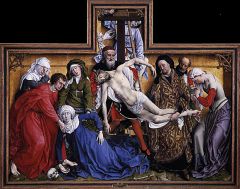
|
Roger van der Weyden, Deposition, Belgium, 1435 (Late Gothic Realism); very realistic: Gothic; Christ & Mary's bodies are parrallel because Mary feels Christ's pain; very emotional
|
|
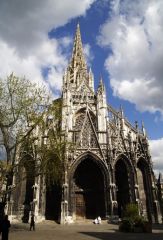
|
Saint Maclou, Rouen, France, probably by Pierre Robin, 1432-1521 (Late Gothic);
|
|
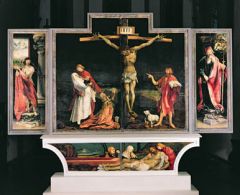
|
Matthias Grünewald, Isenheim altarpiece, Germany, 1510-15 (Late Gothic/Renaissance); N. Reniassance winged altarpieces are a big deal at the time; using realism to make an emotional point (Christ's lips are turning blue, hands are twisted in pain): Christ comes back and you see him painted in lots of colors
|
|
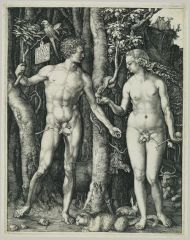
|
Albrecht Dürer, Adam and Eve, 1504 (Northern Renaissance); they are being portrayed in a very Classical way
|

